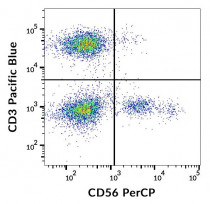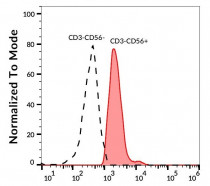ARG53879
anti-CD56 / NCAM antibody [MEM-188] (PerCP)
anti-CD56 / NCAM antibody [MEM-188] (PerCP) for Flow cytometry and Human,Primates
Developmental Biology antibody; Neuroscience antibody; General Lymphocyte Marker Study antibody; Natural killer cells antibody
Overview
| Product Description | PerCP-conjugated Mouse Monoclonal antibody [MEM-188] recognizes CD56 / NCAM |
|---|---|
| Tested Reactivity | Hu, NHuPrm |
| Tested Application | FACS |
| Specificity | The clone MEM-188 reacts with a 180 kDa isoform of CD56 (NCAM) expressed in leukocytes. It has been suggested that the antibody MEM-188 could react with rhesus monkey lymphocytes. Reactivity with other NCAM isoforms has not been tested. HLDA VI; WS code A055 HLDA VI; WS Code NK26 HLDA VII; WS code 70077 |
| Host | Mouse |
| Clonality | Monoclonal |
| Clone | MEM-188 |
| Isotype | IgG2a |
| Target Name | CD56 / NCAM |
| Antigen Species | Human |
| Immunogen | KG-1 human acute myelogenous leukemia cell line |
| Conjugation | PerCP |
| Alternate Names | CD56; NCAM; CD antigen CD56; N-CAM-1; MSK39; NCAM-1; Neural cell adhesion molecule 1 |
Application Instructions
| Application Suggestion |
|
||||
|---|---|---|---|---|---|
| Application Note | * The dilutions indicate recommended starting dilutions and the optimal dilutions or concentrations should be determined by the scientist. |
Properties
| Form | Liquid |
|---|---|
| Buffer | PBS, 15 mM Sodium azide and 0.2% (w/v) high-grade protease free BSA |
| Preservative | 15 mM Sodium azide |
| Stabilizer | 0.2% (w/v) high-grade protease free BSA |
| Storage Instruction | Aliquot and store in the dark at 2-8°C. Keep protected from prolonged exposure to light. Avoid repeated freeze/thaw cycles. Suggest spin the vial prior to opening. The antibody solution should be gently mixed before use. |
| Note | For laboratory research only, not for drug, diagnostic or other use. |
Bioinformation
| Database Links | |
|---|---|
| Gene Symbol | NCAM1 |
| Gene Full Name | neural cell adhesion molecule 1 |
| Background | CD56 (NCAM, neural cell adhesion molecule) is a transmembrane glycoprotein of immunoglobulin family serving as adhesive molecule which is ubiquitously expressed in nervous system, usually as 120 kDa, 140 kDa or 180 kDa isoform, and it is also found on T cells and NK cells. Polysialic modification results in reduction of CD56-mediated cell adhesion and is involved in cell migration, axonal growth, pathfinding and synaptic plasticity. CD56 is a widely used neuroendocrine marker with a high sensitivity for neuroendocrine tumours and ovarian granulosa cell tumours. |
| Function | This protein is a cell adhesion molecule involved in neuron-neuron adhesion, neurite fasciculation, outgrowth of neurites, etc. [UniProt] |
| Highlight | Related Antibody Duos and Panels: ARG30313 General Lymphocyte Marker Antibody Panel (CD3, CD14, CD16, CD19, CD56) Related products: CD56 antibodies; CD56 ELISA Kits; CD56 Duos / Panels; Anti-Mouse IgG secondary antibodies; Related news: Exercise encourages NK cell mobilization to shrink tumors Tumor-Infiltrating Lymphocytes (TILs) |
| Research Area | Developmental Biology antibody; Neuroscience antibody; General Lymphocyte Marker Study antibody; Natural killer cells antibody |
| Calculated MW | 95 kDa |
Images (2) Click the Picture to Zoom In
-
ARG53879 anti-CD56 / NCAM antibody [MEM-188] (PerCP) FACS image
Flow Cytometry: Human peripheral blood lymphocytes stained with ARG53879 anti-CD56 / NCAM antibody [MEM-188] (PerCP).
-
ARG53879 anti-CD56 / NCAM antibody [MEM-188] (PerCP) FACS image
Flow Cytometry: Human peripheral blood lymphocytes stained with ARG53879 anti-CD56 / NCAM antibody [MEM-188] (PerCP).









